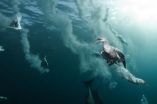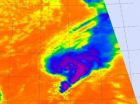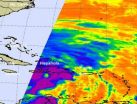(Press-News.org) In a new study out today, researchers used mice to identify a combination six naturally occurring bacteria that eradicate a highly contagious form of Clostridium difficile, an infectious bacterium associated with many hospital deaths. Three of the six bacteria have not been described before. This work may have significant implications for future control and treatment approaches.
The researchers found that this strain of C. difficile, known as O27, establishes a persistent, prolonged contagious period, known as supershedding that is very difficult to treat with antibiotics. These contagious 'supershedders' release highly resistant spores for a prolonged period that are very difficult to eradicate from the environment. Similar scenarios are likely in hospitals.
C. difficile can cause bloating, diarrhoea, abdominal pain and is a contributing factor to over 2,000 deaths in the UK in 2011. It lives naturally in the body of some people where other bacteria in the gut suppress its numbers and prevent it from spreading. If a person has been treated with a broad-spectrum antibiotic such as clindamycin, our bodies' natural bacteria can be destroyed and the gut can become overrun by C. difficile. The aggressive strain of C. diff analysed in this study has been responsible for epidemics in Europe, North America and Australia.
"We treated mice infected with this persistent form of C. diff with a range of antibiotics but they consistently relapsed to a high level of shedding or contagiousness," says Dr Trevor Lawley, first author from the Wellcome Trust Sanger Institute. "We then attempted treating the mice using faecal transplantation, homogenized faeces from a healthy mouse. This quickly and effectively supressed the disease and supershedding state with no reoccurrence in the vast majority of cases."
"This epidemic caused by C. diff is refractory to antibiotic treatment but can be supressed by faecal transplantation, resolving symptoms of disease and contagiousness."
The team wanted to take this research one step further and isolate the precise bacteria that supressed C. diff. and restored microbial balance of the gut. They cultured a large number of bacteria naturally found in the gut of mice, all from one of four main groups of bacteria found in mammals. They tested many combinations of these bacteria, until they isolated a cocktail of six that worked best to suppress the infection.
"The mixture of six bacterial species effectively and reproducibly suppressed the C. difficile supershedder state in mice, restoring the healthy bacterial diversity of the gut," says Professor Harry Flint, senior author from the University of Aberdeen.
The team then sequenced the genomes of the six bacteria and compared their genetic family tree to more precisely define them. Based on this analysis, the team found that the mixture of six bacteria contained three that have been previously described and three novel species. This mix is genetically diverse and comes from all four main groups of bacteria found in mammals.
These results illustrate the effectiveness of displacing C. diff and the supershedder microbiota with a defined mix of bacteria, naturally found in the gut.
"Our results open the way to reduce the over-use of antibiotic treatment and harness the potential of naturally occurring microbial communities to treat C. difficile infection and transmission, and potentially other diseases associated with microbial imbalances," explains Professor Gordon Dougan, senior author from the Wellcome Trust Sanger Institute. "Faecal transplantation is viewed as an alternative treatment but it is not widely used because of the risk of introducing harmful pathogens as well as general patient aversion. This model encapsulates some of the features of faecal therapy and acts as a basis to develop standardized treatment mixture."
###
Notes to Editors
Publication Details
Trevor D. Lawley, Simon Clare, Alan W. Walker, Mark D. Stares, Thomas R. Connor, Claire Raisen, David Goulding, Roland Rad, Fernanda Schreiber, Cordelia Brandt, Laura J. Deakin, Derek J. Pickard, Sylvia H. Duncan, Harry J. Flint, Taane G. Clark, Julian Parkhill, Gordon Dougan (2012). 'Targeted restoration of the intestinal microbiota with a simple, defined bacteriotherapy resolves relapsing Clostridium difficile disease in mice'
Published in PLOS Pathogens on 25 October DOI: ppat.1002995
Funding
This project was funded by the Wellcome Trust and the Medical Research Council.
Participating Centres
Bacterial Pathogenesis Laboratory, Microbial Pathogenesis Laboratory, Pathogen Genomics and Mouse Genomics, Wellcome Trust Sanger Institute, Hinxton, UK,
Microbial Ecology Group, Rowett Institute of Nutrition and Health, University of Aberdeen, Aberdeen AB21 9SB, UK,
Departments of Infectious and Tropical Diseases and Epidemiology and Population Health, London School of Hygiene and Tropical Medicine, London, WC1E 7HT, UK
Selected Websites
For almost 100 years the Medical Research Council has improved the health of people in the UK and around the world by supporting the highest quality science. The MRC invests in world-class scientists. It has produced 29 Nobel Prize winners and sustains a flourishing environment for internationally recognised research. The MRC focuses on making an impact and provides the financial muscle and scientific expertise behind medical breakthroughs, including one of the first antibiotics penicillin, the structure of DNA and the lethal link between smoking and cancer. Today MRC funded scientists tackle research into the major health challenges of the 21st century.
www.mrc.ac.uk
The Wellcome Trust Sanger Institute is one of the world's leading genome centres. Through its ability to conduct research at scale, it is able to engage in bold and long-term exploratory projects that are designed to influence and empower medical science globally. Institute research findings, generated through its own research programmes and through its leading role in international consortia, are being used to develop new diagnostics and treatments for human disease.
http://www.sanger.ac.uk
The Wellcome Trust is a global charitable foundation dedicated to achieving extraordinary improvements in human and animal health. We support the brightest minds in biomedical research and the medical humanities. Our breadth of support includes public engagement, education and the application of research to improve health. We are independent of both political and commercial interests.
http://www.wellcome.ac.uk
Contact details
Don Powell Media Manager
Wellcome Trust Sanger Institute
Hinxton, Cambridge, CB10 1SA, UK
Tel +44 (0)1223 496 928
Mobile +44 (0)7753 7753 97
Email press.office@sanger.ac.uk
C'est difficile
Researchers develop cocktail of bacteria that eradicates Clostridium difficile infection
2012-10-26
ELSE PRESS RELEASES FROM THIS DATE:
Researchers at the doorstep of stem cell therapies for MS, other myelin disorders
2012-10-26
When the era of regenerative medicine dawned more than three decades ago, the potential to replenish populations of cells destroyed by disease was seen by many as the next medical revolution. However, what followed turned out not to be a sprint to the clinic, but rather a long tedious slog carried out in labs across the globe required to master the complexity of stem cells and then pair their capabilities and attributes with specific diseases.
In a review article appearing today in the journal Science, University of Rochester Medical Center scientists Steve Goldman, ...
Traditional fisheries management approach jeopardizes marine ecosystems worldwide
2012-10-26
STONY BROOK, NY– In a Perspectives article, "The Risks of Overfishing," published today in the journal Science, Dr. Ellen K. Pikitch, executive director of the Institute for Ocean Conservation Science and professor at Stony Brook University, cautions against continuing traditional fisheries management. According to Dr. Pikitch, current and recent studies demonstrate the need for "a more precautionary approach to fisheries management, in which fishing is restricted to those places and amounts where it can be conducted safely and with minimal risk of jeopardizing the integrity ...
'Adoption activity days' can help children find new families
2012-10-26
Children's parties or activity days, where prospective adopters meet children awaiting adoption, could be part of the solution to the current adoption crisis, according to research that will be showcased during the Economic and Social Research Council (ESRC) Festival of Social Science.
"Such parties or activity days went out of fashion in the 1980s but no one is sure why," says Katherine Runswick-Cole of Manchester Metropolitan University who led the research. "However, our pilot study has shown an overwhelmingly positive response from practitioners, adopters and the ...
A black widow's Tango Mortale in gamma-ray light
2012-10-26
This press release is available in German.
Pulsars are the compact remnants from explosions of massive stars. Some of them spin around their own axis hundreds of times per second, emitting beams of radiation into space. Until now, they could only be found through their pulsed radio emissions. Now, scientists at the Max Planck Institute for Gravitational Physics (Albert Einstein Institute/AEI) in Hanover assisted by the Max Planck Institute for Radio Astronomy have discovered a millisecond pulsar solely via its pulsed gamma radiation. A new data analysis method developed ...
Smoking takes 10 years off life expectancy in Japan, not 4 as previously thought, experts warn
2012-10-26
Smoking reduces life expectancy by ten years in Japan, but much of the risk can be avoided by giving up smoking, a paper published on bmj.com today shows.
Previous studies in Japan suggested smoking reduced life expectancy by only a few years compared with about ten years in Britain and the USA. This new report, from researchers in Oxford and Japan, investigates the impact of smoking on mortality in a large group of Japanese people who were living in Hiroshima or Nagasaki in 1950. The findings are, however, nothing to do with radiation exposure from the bombs.
The ...
US investment in biomedical and health research on downward trend
2012-10-26
WASHINGTON, DC—October 25, 2012—Biomedical and health research and development (R&D) spending from all sources declined by more than $4 billion or 3% between FY10 and FY11 according to Research!America's 2011 U.S. Investment in Health Research report. This represents the first drop in overall spending since Research!America began compiling the data in 2002.
The decline follows an uptick in research funding attributed to the American Recovery and Reinvestment Act (ARRA), which allocated $10.4 billion to the National Institutes of Health (NIH) over two fiscal years (2009-2010). ...
NASA sees warming cloud tops indicating Tropical Storm Tony weakening
2012-10-26
In a tropical cyclone, strong uplift of air pushes the tops of thunderstorms high into the troposphere. When that strength wanes, the cloud tops drop and become less cold. That's because the higher you go in the troposphere, the colder it gets. NASA satellite infrared data has revealed that Tropical Storm Tony's cloud top temperatures are warming and the storm is weakening.
The Atmospheric Infrared Sounder (AIRS) instrument aboard NASA's Aqua satellite captured infrared imagery of Tropical Storm Tony on Oct. 24 at 12:17 p.m. EDT that showed the strongest thunderstorms ...
NASA sees power in Hurricane Sandy moving toward Bahamas
2012-10-26
NASA's Aqua satellite passed over Hurricane Sandy as it was moving over eastern Cuba early on Oct. 25. The AIRS instrument captured an infrared image of Sandy that showed a large area of very high, cold cloud tops indicating the power within the storm. Sandy is now headed toward the Bahamas and warnings and watches have already been posted for the mainland U.S.
The Atmospheric Infrared Sounder (AIRS) instrument aboard NASA's Aqua satellite captured infrared imagery of Hurricane Sandy's eastern half on Oct. 25 at 0559 UTC (1:59 a.m. EDT) that showed some strong thunderstorms ...
NASA saw Tropical Storm Murjan making landfall on the Horn of Africa
2012-10-26
NASA's Aqua satellite watched from space as Somalia in the Horn of Africa experienced a landfalling tropical cyclone on Oct. 25.
On Oct. 25, NASA's Aqua satellite saw Tropical Storm Murjan begin to make landfall in eastern Somalia, just south of Cape Guardafui. Cape Guardafui is located in the northeastern Bari province and forms the geographical point of the Horn of Africa.
On Oct. 25, 2012 at 0720 UTC (3:20 a.m. EDT) the Moderate Resolution Imaging Spectroradiometer (MODIS) instrument that flies aboard NASA's Aqua satellite captured a visible image of Tropical Storm ...
USF researchers identify gene mutation linked to old age hearing loss
2012-10-26
TAMPA, Fla. (Oct. 25, 2012) - University of South Florida researchers have identified a genetic biomarker for age-related hearing loss, a major breakthrough in understanding and preventing a condition of aging that affects 30 million Americans and greatly diminishes their quality of life.
In a nine-year study that was a collaboration between USF's Global Center for Hearing & Speech Research and the National Technical Institute for the Deaf at the Rochester Institute of Technology, researchers were able to identify the first genetic biomarker for presbycusis. The genetic ...
LAST 30 PRESS RELEASES:
Making lighter work of calculating fluid and heat flow
Normalizing blood sugar can halve heart attack risk
Lowering blood sugar cuts heart attack risk in people with prediabetes
Study links genetic variants to risk of blinding eye disease in premature infants
Non-opioid ‘pain sponge’ therapy halts cartilage degeneration and relieves chronic pain
AI can pick up cultural values by mimicking how kids learn
China’s ecological redlines offer fast track to 30 x 30 global conservation goal
Invisible indoor threats: emerging household contaminants and their growing risks to human health
Adding antibody treatment to chemo boosts outcomes for children with rare cancer
Germline pathogenic variants among women without a history of breast cancer
Tanning beds triple melanoma risk, potentially causing broad DNA damage
Unique bond identified as key to viral infection speed
Indoor tanning makes youthful skin much older on a genetic level
Mouse model sheds new light on the causes and potential solutions to human GI problems linked to muscular dystrophy
The Journal of Nuclear Medicine ahead-of-print tip sheet: December 12, 2025
Smarter tools for peering into the microscopic world
Applications open for funding to conduct research in the Kinsey Institute archives
Global measure underestimates the severity of food insecurity
Child survivors of critical illness are missing out on timely follow up care
Risk-based vs annual breast cancer screening / the WISDOM randomized clinical trial
University of Toronto launches Electric Vehicle Innovation Ontario to accelerate advanced EV technologies and build Canada’s innovation advantage
Early relapse predicts poor outcomes in aggressive blood cancer
American College of Lifestyle Medicine applauds two CMS models aligned with lifestyle medicine practice and reimbursement
Clinical trial finds cannabis use not a barrier to quitting nicotine vaping
Supplemental nutrition assistance program policies and food insecurity
Switching immune cells to “night mode” could limit damage after a heart attack, study suggests
URI-based Global RIghts Project report spotlights continued troubling trends in worldwide inhumane treatment
Neutrophils are less aggressive at night, explaining why nighttime heart attacks cause less damage than daytime events
Menopausal hormone therapy may not pose breast cancer risk for women with BRCA mutations
Mobile health tool may improve quality of life for adolescent and young adult breast cancer survivors
[Press-News.org] C'est difficileResearchers develop cocktail of bacteria that eradicates Clostridium difficile infection




